愛媛大学 理工学研究科
Research Projects
Mechanisms of soil liquefaction
1 Damage due to thin liquefied layers
2 Effects of pre-shearing induced small volumetric strain on the liquefaction behavior of sand
3 Large scale flowslide due to the 2018 Sulawesi Earthquake
4 Related publications
Damage due to thin liquefied layers
More than 2000 river levees were damaged by the 2011 Off the Pacific Coast
of Tohoku Earthquake and liquefaction of soils in levees is considered
to be the fundamental mechanism of about 80% of the damaged levees. Vulnerability
assessment of existing levees and execution of remedial countermeasure
for this newly realized mechanism will be the next challenge. In this study
the validity of the liquefaction evaluation method used in the current
practice was examined. It was revealed that the current method provides
the factor of safety against liquefaction, FL, for relatively thin saturated
layers in levees excessively on the safe side. A possible reason for this
is considered to be drainage of generated excess pore pressure during the
earthquake shaking. An attempt was made to improve the liquefaction evaluation
method by taking the drainage effects into account.
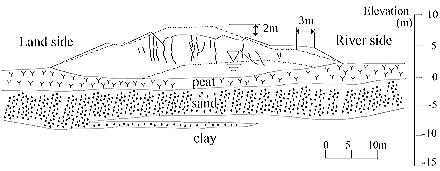
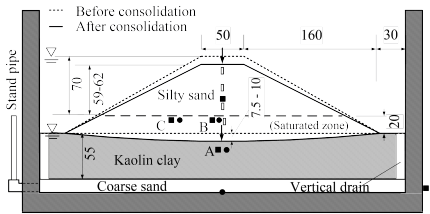
Effects of pre-shearing induced small volumetric strain on the liquefaction behavior of sand
The liquefaction resistance of sand increases with cyclic pre-shearing
and pre-shaking as a result of earthquakes if the strain level in the pre-shearing
is small. When larger shear strains are imposed, liquefaction resistance
decreases. These complicated effects of pre-shearing histories on the liquefaction
resistance are investigated in this study through a series of cyclic triaxial
tests. Various combinations of cyclic stress amplitude and number of cycles
of pre-shearing are examined. It is verified that for the range of shear
strain amplitude in pre-shearing smaller than 0.35%, the liquefaction resistance
increases with pre-shearing. The increase in the liquefaction resistance
depends solely on the volumetric strain in the pre-shearing, and several
effects of the shear stress amplitude and number of cycles can be negligible.
Meanwhile, in the range of shear strain amplitude larger than 0.6%, the
liquefaction resistance decreases. The liquefaction resistance decreases
as the shear strain amplitude increases. The shear strain amplitude is
one of the factors dominating this degrading effect, and the volumetric
strain exerts beneficial effects to a certain extent. In this study, another
series of tests are conducted to investigate the combined effects of small
and large strain amplitude pre-shearing. It is observed that small shear
strain pre-shearing cycles subsequent to large shear strain cycles erased
the degrading effect of the latter. However, a large shear strain pre-shearing
after small strain cycles degrades the beneficial effect of the small shear
strain pre-shearing cycles previously applied to the specimens; however,
the effects of the former small strain pre-shearing remains.
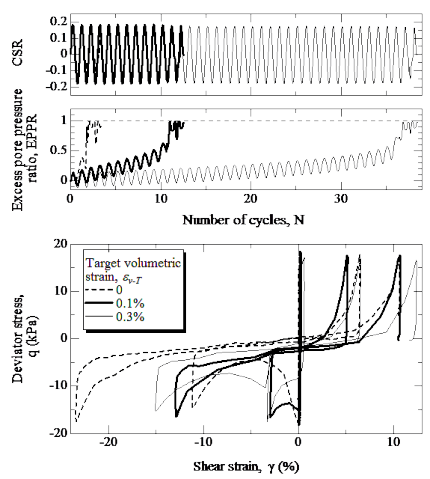
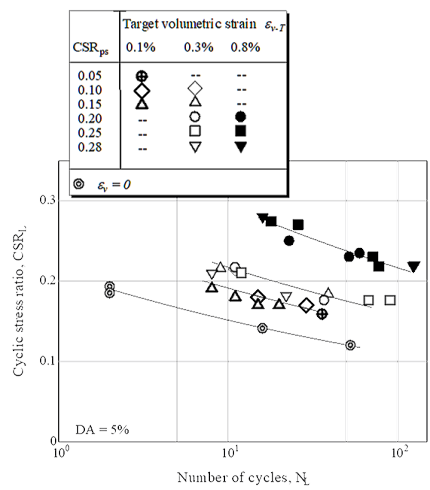
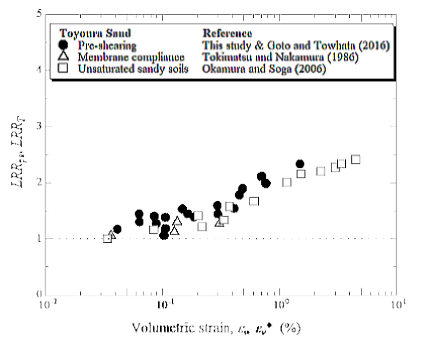 FIGURES
FIGURES
Upper-Left:Results of triaxial liquefaction tests on three specimens with identical density but different pre-shearing histories. Broken line corresponds to a specimen without pre-shearing; thick solid lines indicate responses of specimens with a drained pre-shearing which caused 0.1% volumetric contraction. Thin solid line is the results from a specimen with 0.5% vol. strain.
Upper-right:Liquefaction resistance curves of variety of drained pre-shearing histories.
Lower-left: Relationship between liquefaction resistance ratios (LRR) and pre-shearing volumetric strain, together with results of tests on unsaturated sands. LRR is well correlated with volumetric strain.
Large scale flowslide due to the 2018 Sulawesi Earthquake
 The 2018 Sulawesi Earthquake of Mw7.5 hit the Central Sulawesi province in Indonesia on 28th September 2018 and liquefaction-induced large scale grand flow occurred at several areas in Palu city and neighborhood. A significant characteristics of the grand flow at the sites is that large areas with gentle topographic gradient slid downslope and travelled extraordinary long distances, more than several hundred meters. This Geo-disaster report summarizes site investigation conducted at Sibalaya, one of the site where massive ground flow occurred, to facilitate a better understanding of fundamental mechanisms contributing to the ground flows.
The 2018 Sulawesi Earthquake of Mw7.5 hit the Central Sulawesi province in Indonesia on 28th September 2018 and liquefaction-induced large scale grand flow occurred at several areas in Palu city and neighborhood. A significant characteristics of the grand flow at the sites is that large areas with gentle topographic gradient slid downslope and travelled extraordinary long distances, more than several hundred meters. This Geo-disaster report summarizes site investigation conducted at Sibalaya, one of the site where massive ground flow occurred, to facilitate a better understanding of fundamental mechanisms contributing to the ground flows.
Verbal evidences were collected from many interviewees which reveal time sequence of the event happened in the site, including the main shaking followed by a sudden drop, timing of initiation of the massive ground flow and extremely large sound, and change in water level in wells. Significant contribution of water leakage from the unlined irrigation channel was confirmed to have risen the ground water level in this area, and thus increased in the liquefaction potential. In situ tests including eight large trench excavation and DCPT were carried out which are greatly helpful to identify the liquefied and largely sheared layers. Analysis of topography change using satellite images and UAV photos were also invaluable to capture overall figure of the event. Finally, hypothesized mechanism of the extreme long slide are studied.
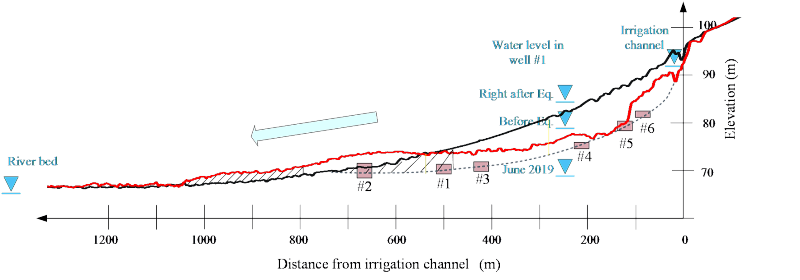
Related publications
M. Okamura and S. Hayashi (2014): Damage to river levees by the 2011 Off the Pacific Coast Tohoku earthquake and prediction of liquefaction in levees, Geotechnics for Catastrophic Flooding Events – Iai (Ed) Taylor & Francis Group, ISBN 978-1-138-02709-1, pp. 57- 67
Mitsu Okamura, Shuji Tamamura and Rikuto Yamamoto (2013): Seismic stability
of embankment subjected to pre-deformation due to foundation consolidation.
Soils and Foundations, Vol. 53, No. 1, pp. 11-22.
F. Nelson and M. Okamura (2017): Effects of the volumetric strain due to pre-shaking on liquefaction resistance, Proc. 16th World Conference on Earthquake, 16WCEE, paper No. 3073.
Mitsu Okamura, Fred Nelson and Shota Watanabe (2018): Pre-shaking effects
on volumetric strain and cyclic strength of sand and comparison to unsaturated
soils, International Journal of Soil Dynamics and Earthquake Engineering,
Vol. 124, pp. 307-316, https://doi.org/10.1016/j.soildyn.2018.04.046
Nelson Fred and Mitsu Okamura (2019): Influence of strain histories on liquefaction resistance of sand, Soils and Foundations, Vol. 59, No. 5, pp.1481-1495. https://doi.org/10.1016/j.sandf.2019.06.011
Mitsu Okamura, Kohei Ono, Utari S. Minaka, Ardy Arsyad, Sukiman Nurdin (2020): Large scale flowslide in Sibalaya due to the 2018 Sulawesi Earthquake, Soils and Foundations, Vol.**, pp.**. Accepted 2020.03.27